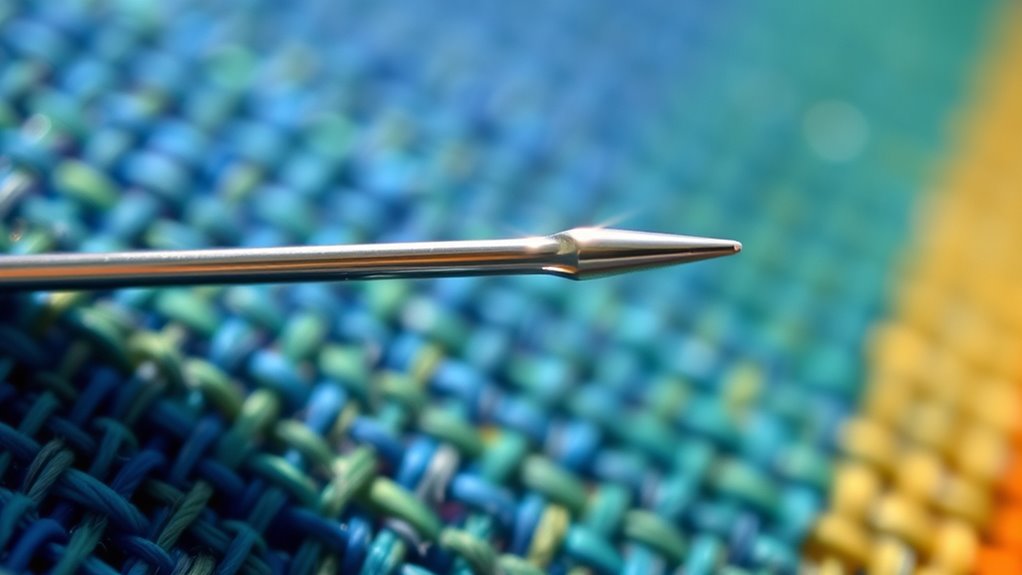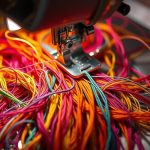When sewing canvas, you should use either a heavy-duty needle or a denim needle. These needles have the strength needed to handle the thickness of the fabric. A size 16 or 18 is ideal for heavy layers. For coated canvas, consider using a wedge needle. Remember, the right needle and thread type are essential for achieving durable seams. If you want to explore more tips and techniques for working with canvas, there’s plenty more to discover.
Understanding Canvas Fabric
When you’re working with canvas fabric, it’s vital to grasp its key characteristics. Canvas is a heavy-duty fabric known for its exceptional durability, making it ideal for a range of applications, from outdoor gear to home decor. Its tight weave contributes to its strength, resisting wear and tear over time.
Additionally, canvas often comes treated with water-resistant coatings, further enhancing its longevity. This fabric typically consists of cotton or polyester, both of which add to its sturdiness. Understanding these canvas characteristics will help you choose the right materials and techniques for your projects.
Types of Needles for Canvas
Choosing the right needle for sewing canvas is essential for achieving strong, reliable seams. Different canvas needle types cater to various sewing techniques. The most common are the heavy-duty needles, which feature a larger eye and thicker shaft, perfect for handling the dense fibers of canvas.
You may also consider using denim needles, as they’re designed for thick fabrics and can penetrate multiple layers easily. If you’re working with coated canvas, a wedge needle can help prevent damage to the material while ensuring smooth stitches. For best results, always match your needle size to the thickness of your canvas and the type of thread you’re using.
Universal Needles
Although universal needles are versatile and can be used for a variety of fabrics, they may not be the best choice for heavy canvas projects. These needles typically feature a medium-sized shaft and a slightly rounded tip, suitable for lightweight to medium-weight materials.
When working with canvas, you need stronger needle materials, like those found in specialized needles. To guarantee peak performance, proper needle maintenance is vital. Regularly check for needle wear and replace them as needed to avoid fabric damage.
Using a universal needle on heavy canvas may lead to skipped stitches or breakage, so consider your project’s demands carefully. For best results, opt for needles specifically designed for heavy fabrics when tackling canvas projects.
Jeans/Denim Needles
If you’re working with heavy canvas, jeans or denim needles are an excellent choice. These needles feature a thicker shaft and a sharp point, designed to penetrate multiple layers of fabric. They help create strong jeans stitches, ensuring your seams hold up under stress. The needle durability is essential, especially when sewing through tough materials. Using the right needle not only improves your sewing experience but also enhances the longevity of your projects.
| Needle Type | Purpose | Recommended Size |
|---|---|---|
| Jeans Needle | Heavy fabrics | 14/90 |
| Denim Needle | Multiple layers of denim | 16/100 |
| Universal Needle | General sewing | 11/75 |
| Twin Needle | Decorative stitches | 2.0mm |
Leather Needles
When sewing leather, choosing the right needle is essential for achieving clean, professional results. Leather needles have a distinctive wedge-shaped point that makes it easier to penetrate thick materials without causing damage. Understanding the different types of leather needles and their sizes can greatly enhance your sewing experience.
Needle Types Comparison
Which leather needle is best for your project? When comparing needle types, consider the needle materials and sewing techniques you’ll use. Leather needles are specifically designed with a wedge-shaped point that easily penetrates thick fabrics.
Here’s a comparison table to help you choose:
| Needle Type | Best Use | Key Features |
|---|---|---|
| Leather Needle | Leather, heavy fabrics | Wedge point, sharp tip |
| Universal Needle | Variety of fabrics | Versatile, rounded point |
| Denim Needle | Thick denim materials | Strong, sharp, thicker shaft |
| Ballpoint Needle | Knits and stretch fabrics | Rounded point, prevents snags |
| Quilting Needle | Layered fabrics | Dual grooves, prevents bunching |
Choose wisely based on your project’s requirements!
Benefits of Leather Needles
While you might be tempted to use a standard needle for leather projects, opting for a leather needle can greatly enhance your sewing experience. Leather needle advantages include a specially designed cutting point that easily penetrates thick materials without damaging them. This design guarantees cleaner stitches and reduces the risk of tearing the leather, which is essential for durability.
There are several leather needle types, including standard, curved, and double needles, each serving unique purposes depending on your project. For instance, curved needles are ideal for sewing in tight spaces, while double needles can create parallel stitching lines. By choosing the right leather needle, you’ll improve both the quality of your work and efficiency in your sewing tasks.
Proper Needle Size
Choosing the proper needle size is essential for sewing leather effectively, as it directly impacts stitch quality and material integrity. For leather projects, you’ll typically want to use a leather needle, which has a wedge-shaped point to penetrate the material without tearing.
- Use a needle size between 90/14 and 110/18 for most leather types.
- Always verify proper needle identification by checking the needle’s packaging.
- Follow needle maintenance tips, such as changing needles regularly to avoid dullness and guarantee clean stitches.
Using the right needle size not only enhances your sewing experience but also prolongs the life of your leather project. So, invest time in selecting the proper needle for the best results.
Ballpoint Needles
Ballpoint needles feature a rounded tip that pushes fabric fibers apart instead of cutting them, making them ideal for knit and stretch fabrics. When sewing canvas, using the right needle type can prevent snags and damage. Understanding their design and fabric compatibility guarantees the best stitching results.
Needle Design Features
When it comes to sewing canvas, the design features of ballpoint needles play an essential role in achieving clean, professional results. The unique needle structure is specifically engineered to navigate through tightly woven fabrics without damaging the fibers. Understanding the needle anatomy helps you appreciate how the rounded tip smoothly pushes aside material rather than piercing it.
- Rounded Tip: Prevents snagging and tearing in canvas fibers.
- Stronger Shaft: Provides durability to withstand the heavy weight of canvas.
- Larger Eye: Accommodates thicker threads, ensuring consistent tension.
Ideal Fabric Compatibility
Understanding fabric compatibility is essential for achieving ideal results with ballpoint needles. These needles are specifically designed for knit and stretch fabrics, making them suitable for canvas that has a bit of give.
When dealing with canvas weight considerations, guarantee your ballpoint needle matches the fabric’s thickness; a larger needle is better for heavier canvas. Additionally, when employing fabric layering techniques, use a ballpoint needle to prevent snagging or damaging the fibers, especially in seams where multiple layers meet.
This compatibility helps maintain the integrity of the fabric while allowing for flexibility and movement. Remember, choosing the right needle enhances your sewing experience and guarantees durable, high-quality results in your canvas projects.
Needle Size Recommendations
Choosing the right needle size is essential for successful canvas sewing projects. You’ll need to take into account needle thickness options to guarantee your needle can handle the heavy fabric without damaging it. For most canvas projects, a size 16 or 18 needle works best, as they provide the strength needed for thicker materials.
Selecting the appropriate needle size is crucial for successful canvas sewing, with size 16 or 18 offering the best strength for heavy fabrics.
Here are some recommendations:
- Universal Needles: Good for various canvas types.
- Jeans/Denim Needles: Designed for heavy fabrics, offering extra strength.
- Brand Recommendations: Look for trusted brands like Schmetz or Organ for consistent quality.
Using the right needle size not only makes your sewing smoother but also helps achieve a professional finish on your canvas creations.
Choosing the Right Thread
Selecting the right thread is essential for guaranteeing durability and strength in your canvas projects. You’ll want to take into account both thread weight and durability when making your choice. Thicker threads offer greater durability, while lighter threads provide flexibility. Here’s a quick reference table to help you decide:
| Thread Type | Weight (Denier) | Durability Level |
|---|---|---|
| Polyester | 300D | High |
| Nylon | 500D | Very High |
| Cotton | 100D | Moderate |
Using the right combination of thread weight and type can notably impact the longevity of your canvas creations. Always opt for high-quality materials to guarantee your projects withstand wear and tear.
Tips for Sewing Canvas Effectively
When working with canvas, using the right thread is just the beginning. To achieve the best results, focus on effective sewing techniques and proper fabric preparation. Here are some tips to enhance your sewing experience:
- Pre-wash the canvas: This removes any sizing and guarantees the fabric shrinks before you start sewing.
- Use a walking foot: This helps prevent the canvas from slipping and guarantees even stitching.
- Stabilize seams: Use bias tape or interfacing to reinforce seams and prevent fraying.
Frequently Asked Questions
Can I Use a Regular Sewing Machine for Canvas?
Yes, you can use a regular sewing machine for canvas, but you’ll need heavy-duty needles. Make sure your machine’s capable of handling thick materials, or you might face frustrating jams or broken needles.
What Is the Best Thread Type for Canvas Sewing?
For sewing canvas, you should use polyester or nylon thread for durability. A thread weight of 30 to 40 is ideal, providing strength and flexibility, ensuring your seams withstand stress and wear effectively.
How Do I Prevent Fabric From Slipping While Sewing?
Ever tried sewing slippery fabric without it bunching up? To prevent slipping, use fabric stabilizers and secure layers with sewing clips. These tools keep your fabric aligned, ensuring a smooth, precise sewing experience every time.
Is It Necessary to Prewash Canvas Before Sewing?
Yes, prewashing canvas is necessary. It helps eliminate dirt and finishes, plus it prevents canvas shrinkage after sewing, ensuring your final project maintains its intended size and appearance. Prewashing benefits your overall sewing experience.
Can I Hand-Sew Canvas, and How?
You can definitely hand-sew canvas. Picture it as weaving a tapestry; use strong stitching techniques like the backstitch or whipstitch for durability. Just remember, patience and precision are your best allies in this endeavor.


